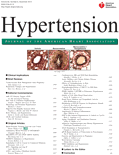Hypertension:肾去交感神经术后单交感神经发放显著减少
2012-11-28 高晓方译 Hypertension
澳大利亚学者的一项研究表明,肾去交感神经术(RDN)可显著并迅速降低单交感性缩血管神经纤维的发放特性。论文于2012年11月19日在线发表于《高血压》(Hypertension)杂志。 此项研究共纳入35例顽固性高血压患者,并在基线和随访3个月时测定了标准诊室血压、单单位肌肉交感神经活性(MSNA)和多单位MSNA。25例患者接受RDN治疗,10例未行RDN的患者接受重复测定。尽管分别平
澳大利亚学者的一项研究表明,肾去交感神经术(RDN)可显著并迅速降低单交感性缩血管神经纤维的发放特性。论文于2012年11月19日在线发表于《高血压》(Hypertension)杂志。
此项研究共纳入35例顽固性高血压患者,并在基线和随访3个月时测定了标准诊室血压、单单位肌肉交感神经活性(MSNA)和多单位MSNA。25例患者接受RDN治疗,10例未行RDN的患者接受重复测定。尽管分别平均应用(4.8±0.4)和(4.4±0.5)种加压药物,但RDN组和非RDN组的基线平均血压仍为164/93 mmHg和164/87 mmHg。
结果显示,在随访3个月时,RDN组的平均诊室收缩压和舒张压分别显著降低13 mmHg和6 mmHg,非RDN组则无显著变化。RDN轻度降低了多单位MSNA,但随访时包括血管收缩神经纤维发放率、发放可能性以及一个心动周期内单单位多重发放发生率在内的所有单单位MSNA特性均出现实质性降低。随访时非RDN人群的血压、单单位MSNA和多单位MSNA保持不变。

Abstract
Renal denervation (RDN) has been shown to reduce blood pressure (BP) and muscle sympathetic nerve activity (MSNA) in patients with resistant hypertension. The mechanisms underlying sympathetic neural inhibition are unknown. We examined whether RDN differentially influences the sympathetic discharge pattern of vasoconstrictor neurons in patients with resistant hypertension. Standardized office BP, single-unit MSNA, and multi-unit MSNA were obtained at baseline and at 3-month follow-up in 35 patients with resistant hypertension. Twenty-five patients underwent RDN, and 10 patients underwent repeated measurements without RDN (non-RDN). Baseline BP averaged 164/93 mm Hg (RDN) and 164/87 mm Hg (non-RDN) despite use of an average of 4.8±0.4 and 4.4±0.5 antihypertensive drugs, respectively. Mean office BP decreased significantly by −13/−6 mm Hg for systolic BP (P<0.001) and diastolic BP (P<0.05) with RDN but not in non-RDN at 3-month follow-up. RDN moderately decreased multi-unit MSNA (79±3 versus 73±4 bursts/100 heartbeats; P<0.05), whereas all properties of single-unit MSNA including firing rates of individual vasoconstrictor fibers (43±5 versus 27±3 spikes/100 heartbeats; P<0.01), firing probability (30±2 versus 22±2% per heartbeat; P<0.02), and multiple firing incidence of single units within a cardiac cycle (8±1 versus 4±1% per heartbeat; P<0.05) were substantially reduced at follow-up. BP, single-unit MSNA, and multi-unit MSNA remained unaltered in the non-RDN cohort at follow-up. RDN results in the substantial and rapid reduction in firing properties of single sympathetic vasoconstrictor fibers, this being more pronounced than multi-unit MSNA inhibition. Whether the earlier changes in single-unit firing patterns may predict long-term BP response to RDN warrants further exploration.
本网站所有内容来源注明为“梅斯医学”或“MedSci原创”的文字、图片和音视频资料,版权均属于梅斯医学所有。非经授权,任何媒体、网站或个人不得转载,授权转载时须注明来源为“梅斯医学”。其它来源的文章系转载文章,或“梅斯号”自媒体发布的文章,仅系出于传递更多信息之目的,本站仅负责审核内容合规,其内容不代表本站立场,本站不负责内容的准确性和版权。如果存在侵权、或不希望被转载的媒体或个人可与我们联系,我们将立即进行删除处理。
在此留言








#PE#
70
#TENS#
76
#Hypertension#
77